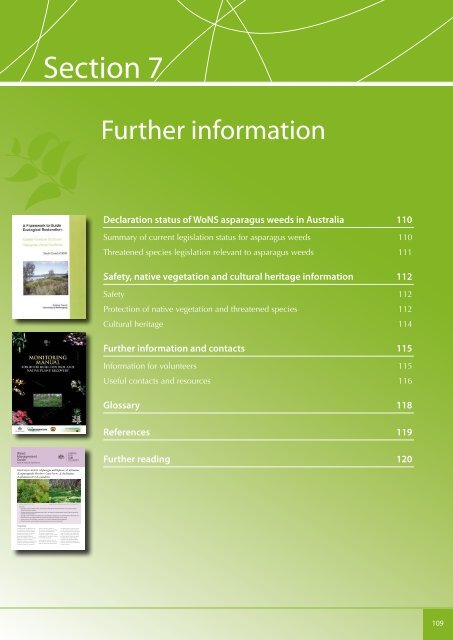Asparagus weeds - Weeds Australia
Asparagus weeds - Weeds Australia
Asparagus weeds - Weeds Australia
- No tags were found...
You also want an ePaper? Increase the reach of your titles
YUMPU automatically turns print PDFs into web optimized ePapers that Google loves.
<strong>Asparagus</strong> aethiopicus. Photo: H. Cherry.Key points• <strong>Asparagus</strong> <strong>weeds</strong> are highly invasive, vine-like plants that degrade native biodiversity. They establish readily indisturbed and intact bushland.• Gardens commonly contain asparagus <strong>weeds</strong>, which can be spread in dumped garden waste. Birds also spread thefleshy berries long distances.• <strong>Asparagus</strong> <strong>weeds</strong> smother native plants and create damaging, underground root mats that persist after plants arekilled. Root mats may impede native plant regeneration and promote growth of other <strong>weeds</strong>.• Follow-up control and restoration is necessary for successful asparagus weed management.• Prevention is best. Learn to identify asparagus <strong>weeds</strong> and remove new infestations.<strong>Asparagus</strong> <strong>weeds</strong> are aggressive vinelikeplants that are highly invasive insub-tropical and temperate bushlandand coastal ecosystems of <strong>Australia</strong>.Seven species of asparagus arerecognised as <strong>Weeds</strong> of NationalSignificance (WoNS): ground asparagus(<strong>Asparagus</strong> aethiopicus), climbingasparagus (A. africanus), common bridalcreeper (A. asparagoides) and WesternCape bridal creeper (A. asparagoidesWeed Management guide ASPARAGUS.indd 1Western Cape form), bridal veil(A. declinatus), climbing asparagus fern(A. plumosus) and asparagus fern(A. scandens). A separate weedmanagement guide exists for commonbridal creeper (A. asparagoides), which isnot included in this guide.Introduced from southern Africa inthe mid-1800s, asparagus <strong>weeds</strong> wereespecially popular as hanging basket<strong>Asparagus</strong> declinatus invading native bushland. Photo: S. Potter, Biosecurity SA.and garden plants and several speciesare still commonly traded. They haveescaped from gardens to become major<strong>weeds</strong>. The fleshy fruits of asparagus<strong>weeds</strong> are spread extensively by birdsand other animals. Plants also spreadvegetatively by rhizomes dumpedin garden waste. Seedlings establishreadily in undisturbed bushland, andplants survive in a range of habitats andclimatic conditions.29/05/13 1:20 PMSection 7Further informationDeclaration status of WoNS asparagus <strong>weeds</strong> in <strong>Australia</strong> 110Summary of current legislation status for asparagus <strong>weeds</strong> 110Threatened species legislation relevant to asparagus <strong>weeds</strong> 111Safety, native vegetation and cultural heritage information 112Safety 112Protection of native vegetation and threatened species 112Cultural heritage 114Further information and contacts 115Information for volunteers 115Useful contacts and resources 116Glossary 118References 119WeedManagementGuideWeed of National SignificanceFurther reading 120<strong>Asparagus</strong> <strong>weeds</strong> (<strong>Asparagus</strong> aethiopicus, A. africanus,A. asparagoides Western Cape form, A. declinatus,A. plumosus and A. scandens)The problem109
















